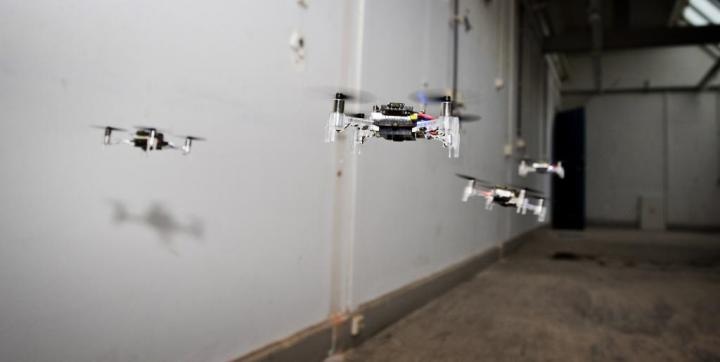Oct 24 2019
Scientists have developed a swarm of miniature drones that can investigate unfamiliar environments totally by themselves. This study, published in the October 23rd issue of the Science Robotics, forms a major step in the domain of swarm robotics.
 The drones explore the environment by flying into different directions. When a drone notices another drone in its preferred direction, it will attempt to fly in a different direction. When this is not possible (as in this picture), the lower priority drones will move out of the way of the higher priority drones. Drones deal with obstacles on the fly, and by doing so enter and exit different rooms. (Photo credit: Guus Schoonewille, TU Delft)
The drones explore the environment by flying into different directions. When a drone notices another drone in its preferred direction, it will attempt to fly in a different direction. When this is not possible (as in this picture), the lower priority drones will move out of the way of the higher priority drones. Drones deal with obstacles on the fly, and by doing so enter and exit different rooms. (Photo credit: Guus Schoonewille, TU Delft)
The challenge is posed by the fact that the miniature 33-gram drones have to steer autonomously while having very limited sensing and computational capabilities.
The collaborative research team—with scientists from TU Delft, University of Liverpool, and Radboud University of Nijmegen—overcame this challenge by taking inspiration from the relative effortlessness of insect navigation.
Inspiration from Nature
Roboticists have been inspired by insect swarms and believe that small robots may also be able to tackle their individual restrictions by working in a swarm. Swarms of small and economical robots would be able to carry out operations that are impractical for large, individual robots at present. For example, a swarm of small flying drones would be able to investigate a disaster site a lot quicker compared to a single larger drone. Such swarms are yet to evolve.
Search and Rescue
In the last four years, a collaborative research group of the universities of TU Delft, University of Liverpool, and Radboud University of Nijmegen, funded by the Dutch national science foundation NWO Natural Artificial Intelligence program, has worked toward designing a swarm of miniature drones capable of exploring unfamiliar environments. The research project’s goal was to pave the way toward employing swarms of drones in search-and-rescue situations.
The key concept was that in the future, rescue personnel would be able to release a swarm of miniature drones to search a disaster site such as a building that is on the verge of collapsing. The swarm of drones will make their way into the building, explore it, and return to the base station with significant information. The rescue team can then concentrate their efforts on the most relevant areas—for example, people stuck inside.
Finding Victims
As part of the project, miniature drones were fitted with cameras and released into an indoor office setting to locate two dummies that mimic victims in a disaster setup. This proof-of-concept search-and-rescue task evidently revealed the benefit of having a swarm.
Within six minutes, a swarm of six drones was able to investigate approximately 80% of the open rooms—which would be difficult for a solo drone to achieve. Moreover, swarming also turned out to be beneficial for redundancy. One drone located a victim, but because of camera hardware failure, it could not take back any images. Fortunately, another drone was able to get the victim on camera.
Challenge
The biggest challenge in achieving swarm exploration lies at the level of the individual intelligence of the drones. In the beginning of the project, we focused on achieving basic flight capabilities such as controlling the velocity and avoiding obstacles. After that, we designed a method for the small drones to detect and avoid each other.
Kimberly McGuire, PhD Student, TU Delft
Kimberly McGuire continued, “We solved this by having each drone carry a wireless communication chip and then making use of the signal strength between these chips—this is like the number of bars shown on your phone that decrease when you move away from your WiFi router in your home. The main advantages of this method are that it does not require extra hardware on the drone and that it requires very few computations.”
Autonomous Navigation
While conducting swarm investigation, the most intimidating challenge was to make the small robots steer through unknown environment on their own. This is because the miniature robots are highly restricted in terms of computation and sensing.
Yet again, nature offered a vital inspiration. Insects do not make very exhaustive maps. Instead, they preserve landmarks and behaviorally relevant places such as food sources and their nest.
The main idea underlying the new navigation method is to reduce our navigation expectations to the extreme: we only require the robots to be able to navigate back to the base station. The swarm of robots first spreads out into the environment by having each robot follow a different preferred direction. After exploring, the robots return to a wireless beacon located at the base station.
Guido de Croon, Project Principal Investigator, TU Delft
Bug Algorithm
“The proposed navigation method is a novel type of bug algorithm,” states Kimberly McGuire.
Bug algorithms do not make maps of the environment but deal with obstacles on the fly. In principle, detailed maps are very convenient, because they allow a robot to navigate from any point in the map to any other point, along an optimal path. However, the costs of making such a map on tiny robots is prohibitive. The proposed bug algorithm leads to less efficient paths but has the merit that it can even be implemented on tiny robots.
Kimberly McGuire, PhD Student, TU Delft
Swarm exploration by tiny flying robots
(Video credit: TU Delft)